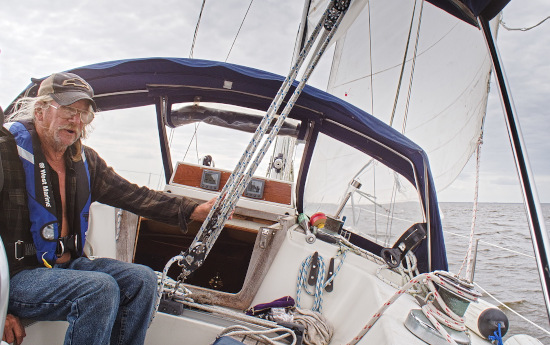Sailing a Sarabande 41
Text and Photograph by Paul Clayton
Most of us on this side of the Atlantic probably don't realize it, but back in the 1970s and 80s the French sailboat manufacturers were among the finest in the world. Beneteau and Jenneau had reputations for building rugged, seaworthy, fast boats that had interior furnishings to compete with Morris and Hinckley. The French designers refined the short fin keel with rudder on a separate skeg and put the nail in the coffin for the makers of heavy, long-keeled, traditional boats. Things started to change in the late 1980s when Beneteau built a factory in South Carolina and started mass-producing boats designed to fill a market for luxury at a low price point. Strength, seaworthiness and solidity took a back seat, and the modern boats are better known for large-volume plush interiors and electronic gadgetry than for solid fiberglass and high-quality deck fittings. The torch of French design has not gone out - it has just migrated to the yard of Henri Amel, in La Rochelle. The Amel Super Maramu is arguably the finest high-latitude, expedition sailboat produced, and certainly one of the most expensive.
The Paul Aubin yard in Nantes, France was started in the 1920s and built wooden boats. The primary architect was Philippe Harle, a respected designer who drew many of the Jenneaus. Around 1980 Chantier Aubin tried their hand at a big, fast fiberglass sloop capable of handling the rough waters of the Bay of Biscay and North Sea. The result was the Sancerre 38. Very few, if any, were exported to the United States. A few years later, Aubin stretched the Sancerre 38 to 41 feet by incorporating a reverse transom with swim platform. The result was the Sarabande 41. Three copies are known to have been exported to the United States.
My friend Dan (Pilot Dan, as opposed to my notorious sometimes sailing partner Spam and Yams Dan) lives aboard his Sarabande 41 Moriahin Edenton, NC. I have spent many enjoyable hours sitting in the cockpit of Moriah at the Edenton Marina dock, talking about sailing and life with Dan and other local denizens. Once Dan gave me a tour of the below-decks, and I was impressed by the beautiful cabinetry and panelling that harkens back to the Aubin yard's heritage of building wooden boats.
Moriah sports a flush deck with plenty of room to work sails. She carries a high-aspect sloop rig, and an inner stay that can be set to fly a storm staysail, if the need presents itself. The hull and deck are thick, rigid, heavily-laid fiberglass and the boat exhibits none of the oil-canning that has led some sailors to refer to modern Beneteaus as "Bendy-teaus". The fittings are solid and the lines handled by big two-speed winches. Auxiliary power is provided by a new Yanmar. Dan likes to sail so the diesel doesn't get much use.
A breezy October morning in 2019 Dan stopped by my boat and asked if I fancied a day-sail aboard Moriah. I had nothing pressing and if I had, I would have dropped it, because I had long hoped for an opportunity to sail aboard her. We cast off at 12:30 and motored out Pembroke Creek, setting sails and shutting down the engine just in front of the town dock. I was at the helm and set a course close-hauled out the bay with a southeasterly wind of around 8-10 knots. Out in the sound, we found better wind and Moriah put her shoulder down. Soon we reached a point where we could fetch the channel under the power lines. With Dan tending the jib sheets, I put the helm down and Moriah came about smartly onto the starboard tack. I passed the wheel to Dan and went below for a cold drink, where I found plenty of hand-holds to move securely.
Back on deck, I settled down on the lee cockpit bench to enjoy the ride as Dan skirted the north shore of the sound. We passed the Albemarle Yacht plant, break-bulk barge facility, country club and golf course, close hauled with a moderate breeze (for the non-sailor readers, "moderate breeze" is a technical term, winds of 11-16 knots on the Beaufort scale, stronger than a gentle breeze but not as strong as a fresh breeze). I was surprised that we carried 20 feet of water well inshore. As we neared the bridge carrying highways 32, 37 and 94 across the sound (the Old Bridge in local idiom), we came about. This time I hauled the sheets, and found that with careful timing I was able to armstrong the lee sheet almost all the way in, needing just a couple turns of the winch to finish setting the jib. With the wind now free over the port quarter, we eased the mainsheet and flew up the sound.
Sailing straight downwind is never any fun, so we continued on the port tack until we reached a point due south of the entrance to Edenton Bay, and then jibed and followed the markers right in to the mouth of Pembroke Creek. There we dropped the sails and motored in to the marina, tying up at 5:30. It had been a great day aboard an uncommon class of boat, one that few people will ever see, much less get a chance to sail.
Text and Photographs by Paul Clayton.
Copyright © 2019 Paul M. Clayton
